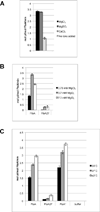A thermosensitive defect in the ATP binding pocket of FtsA can be suppressed by allosteric changes in the dimer interface
- PMID: 25213228
- PMCID: PMC4213309
- DOI: 10.1111/mmi.12790
A thermosensitive defect in the ATP binding pocket of FtsA can be suppressed by allosteric changes in the dimer interface
Abstract
In Escherichia coli, initial assembly of the Z ring for cell division requires FtsZ plus the essential Z ring-associated proteins FtsA and ZipA. Thermosensitive mutations in ftsA, such as ftsA27, map in or near its ATP binding pocket and result in cell division arrest at non-permissive temperatures. We found that purified wild-type FtsA bound and hydrolysed ATP, whereas FtsA27 was defective in both activities. FtsA27 was also less able to localize to the Z ring in vivo. To investigate the role of ATP transactions in FtsA function in vivo, we isolated intragenic suppressors of ftsA27. Suppressor lesions in the ATP site restored the ability of FtsA27 to compete with ZipA at the Z ring, and enhanced ATP binding and hydrolysis in vitro. Notably, suppressors outside of the ATP binding site, including some mapping to the FtsA-FtsA subunit interface, also enhanced ATP transactions and exhibited gain of function phenotypes in vivo. These results suggest that allosteric effects, including changes in oligomeric state, may influence the ability of FtsA to bind and/or hydrolyse ATP.
© 2014 John Wiley & Sons Ltd.
Figures







Similar articles
-
Gain-of-function variants of FtsA form diverse oligomeric structures on lipids and enhance FtsZ protofilament bundling.Mol Microbiol. 2018 Sep;109(5):676-693. doi: 10.1111/mmi.14069. Epub 2018 Aug 1. Mol Microbiol. 2018. PMID: 29995995 Free PMC article.
-
Direct Interaction between the Two Z Ring Membrane Anchors FtsA and ZipA.J Bacteriol. 2019 Jan 28;201(4):e00579-18. doi: 10.1128/JB.00579-18. Print 2019 Feb 15. J Bacteriol. 2019. PMID: 30478085 Free PMC article.
-
Assembly and architecture of Escherichia coli divisome proteins FtsA and FtsZ.J Biol Chem. 2022 Mar;298(3):101663. doi: 10.1016/j.jbc.2022.101663. Epub 2022 Jan 29. J Biol Chem. 2022. PMID: 35104502 Free PMC article.
-
Marching to the beat of the ring: polypeptide translocation by AAA+ proteases.Trends Biochem Sci. 2014 Feb;39(2):53-60. doi: 10.1016/j.tibs.2013.11.003. Epub 2013 Dec 6. Trends Biochem Sci. 2014. PMID: 24316303 Free PMC article. Review.
-
In the beginning, Escherichia coli assembled the proto-ring: an initial phase of division.J Biol Chem. 2013 Jul 19;288(29):20830-20836. doi: 10.1074/jbc.R113.479519. Epub 2013 Jun 5. J Biol Chem. 2013. PMID: 23740256 Free PMC article. Review.
Cited by
-
Role of the antiparallel double-stranded filament form of FtsA in activating the Escherichia coli divisome.bioRxiv [Preprint]. 2024 Jun 30:2024.06.24.600433. doi: 10.1101/2024.06.24.600433. bioRxiv. 2024. Update in: mBio. 2024 Aug 14;15(8):e0168724. doi: 10.1128/mbio.01687-24. PMID: 38979378 Free PMC article. Updated. Preprint.
-
Role of the antiparallel double-stranded filament form of FtsA in activating the Escherichia coli divisome.mBio. 2024 Aug 14;15(8):e0168724. doi: 10.1128/mbio.01687-24. Epub 2024 Jul 23. mBio. 2024. PMID: 39041810 Free PMC article.
-
Bacterial actin and tubulin homologs in cell growth and division.Curr Biol. 2015 Mar 16;25(6):R243-R254. doi: 10.1016/j.cub.2015.01.030. Curr Biol. 2015. PMID: 25784047 Free PMC article. Review.
-
Peptide Linkers within the Essential FtsZ Membrane Tethers ZipA and FtsA Are Nonessential for Cell Division.J Bacteriol. 2020 Feb 25;202(6):e00720-19. doi: 10.1128/JB.00720-19. Print 2020 Feb 25. J Bacteriol. 2020. PMID: 31871036 Free PMC article.
-
A mutation in Escherichia coli ftsZ bypasses the requirement for the essential division gene zipA and confers resistance to FtsZ assembly inhibitors by stabilizing protofilament bundling.Mol Microbiol. 2015 Sep;97(5):988-1005. doi: 10.1111/mmi.13081. Epub 2015 Jul 4. Mol Microbiol. 2015. PMID: 26046682 Free PMC article.
References
-
- Bi EF, Lutkenhaus J. FtsZ ring structure associated with division in Escherichia coli. Nature. 1991;354:161–164. - PubMed
Publication types
MeSH terms
Substances
Grants and funding
LinkOut - more resources
Full Text Sources
Other Literature Sources
Molecular Biology Databases

